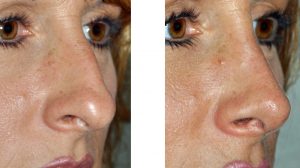
Although rhinoplasty surgery is quite variable, it either involves the external nose only or is combined with internal nasal surgery as well. In a septorhinoplasty, the internal structures of the septum and turbinates are manipulated as well. As a result, dissatisfaction could be either in how the nose looks or about persistent nasal airway obstruction.
The most common appearance problems after rhinoplasty are three-fold. Asymmetry of the nasal tip is most frequently seen. The reasons have to do with the complex nature of the nasal tip. Sitting at the intersection of multiple cartilages, the tip also influences the shape of the nostrils as well. Underneath is also where most of the incisions are placed to perform the procedure. Given these multiple factors, it is no surprise that scar contracture can change even the most perfectly shaped nasal tip created during surgery. Secondary tip problems include asymmetry of the nostrils, persistent tip fullness, and tip deviation.
The two other rhinoplasty appearance issues can be with the middle third of the nose being crooked and having an irregularity in the upper third of the nose. When nasal osteotomies (breaking the nasal bones) needs to be done, this requires the bridge of the nose to be changed. The nasal bridge, while often thought of as just being bone, also involves the junction of where the bone and upper cartilages meet. This complex intersection must be as smooth as possible at the end of the procedure but it is located where direct vision is difficult even during an open rhinoplasty. This smoothing after the bridge is taken done and narrowed is largely done blindly. When combined with the forces of healing, nasal dorsal irregularities are the second most common reason for revisional rhinoplasty in my experience.
Complaints about persistent nasal obstruction can occur after internal nasal structure manipulation. Some short-term stuffiness and congestion is normal for up to 6 weeks or so after surgery. Beyond that the sensation of nasal blockage must be assessed and assumed that there is an actual anatomic reason for it. This may be an undercorrected septal deviation, recurrent septal deviation or a piece of turbinate that has not been removed. In my experience, revisional nasal airway surgery almost always locates and corrects the problem in most cases. Unlike aesthetic revisions of the nose, one does not need to wait more than few months to consider another lok and adjustment at the anatomy of the inside of the nose.
Unlike a functional breathing issue, an aesthetic issue from a rhinoplasty does not always bother the patient or justify revisional surgery. It is well known that plastic surgeons are more critical of how patients look after surgery than the patients themselves. I let patients decide if the prospect of more surgery is worthy of their efforts. It is advised that one should wait at least six months to allow for certainty that the aesthetic is not self-solving and the nasal tissues have relaxed somewhat.
Dr. Barry Eppley
Indianapolis, Indiana


